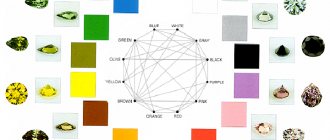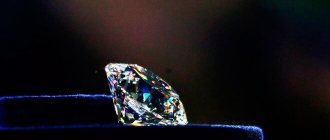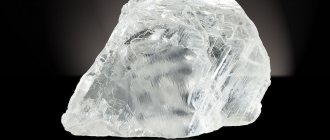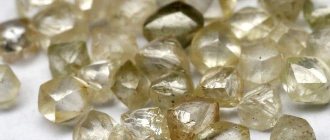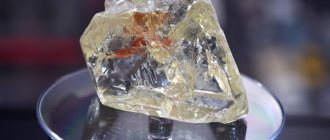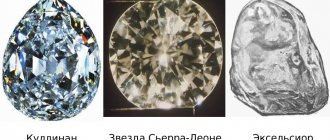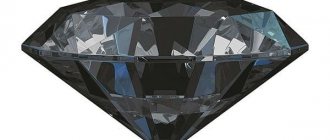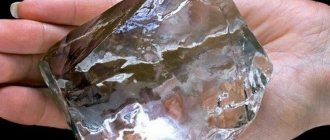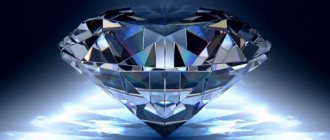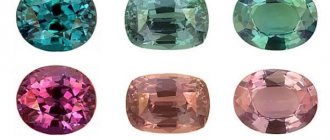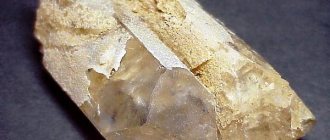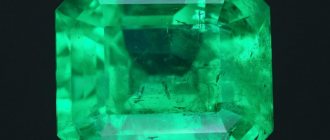There are a large number of different ways to invest money, many of them cannot be called reliable.
If a person wants to invest in precious stones, then he should know the advantages of this:
- the demand for high-quality precious stones, including diamonds, is constantly growing, as is their price;
- diamonds have high liquidity, convertibility is maintained regardless of global or local crises;
- Precious items are not registered by the state, so they cannot be confiscated during legal proceedings.
All these advantages allow diamonds to be an excellent investment value, which is very important in conditions of constant crises and currency falls.
There are world centers that mine precious stones - diamonds or rough diamonds, and they also process them. Financial specialists are actively interested in this industry.
The bulk of supply comes from jewelry cutting centers. They are located in the following countries :
- USA;
- India;
- Belgium;
- Israel.
An important indicator is how much diamonds cost on the market (1 carat). The cost depends on several factors, which you must carefully study before purchasing them. It is advisable to study different offers.
Process for assessing basic qualities
Evaluation of stones is a serious process, so it is carried out by independent experts in a variety of specialized companies or in gemological research laboratories. Among the factors by which diamonds are evaluated and which influence their final value are the following:
- color;
- cutting;
- weight;
- purity;
- the region from which the gemstone came.
So, let's look at each category separately.
Weight
Diamonds have their own unit of measure – the carat. Such a standard was established for them back in 1907. If we delve deeper into the translation system, then a metric carat has 0.2 grams of weight. Of course, you can try and find large diamonds (although, as a rule, they are not sold, but are intended for exhibitions or purchased for private collections), but most stones are small.
If we talk about the work of jewelers, then, as a rule, they often work with small diamonds that weigh no more than half a carat. As already mentioned, their value is determined by purity and color, and they also have their own quality scale. So, if a diamond has clarity and color values of four, the stone is considered high quality. In this case, the price for 0.1 carat will vary from 10,100 to 10,500 rubles.
If we talk about stones larger than 1 carat, then other parameters begin to play a role. The price for 1 carat of a high-quality gem with 4/4 indicators will be from 550 thousand rubles and above. Diamonds of excellent quality (1/1 clarity and color) are priced at twice the price.
How is the price of a diamond determined?
All diamonds first appear on the market as raw materials, then again, but in the form of a diamond. Stones pass through many appraisers, cutters, and intermediaries before ending up in the hands of manufacturers and ultimately jewelry retailers.
As a rule, mining companies independently sort the resulting diamonds and conduct a preliminary assessment of the raw materials based on the classification (more on this later). The diamonds are then put up for auction to find polishers and cutters.
Cut diamonds increase in price even more, primarily due to the labor-intensive processing process by jewelry craftsmen.
The cost of 1 carat of excellent quality diamond, according to the most average data, is about 1.5 million rubles. Average quality stones are estimated at approximately 600-700 thousand rubles.
There is no exactly fixed price for these stones, and this is not only about quality characteristics. The cost of diamonds, like other valuable minerals, is determined depending on production volumes, mining costs and production costs.
Price formation is also influenced by the discovery and launch of new fields, supply and demand on the global market, and the political or financial situation in the world.
Unique diamonds are most valued: for example, the largest diamond, the Cullinan, weighing over 3,100 carats, was valued at $2 billion.
Having become part of a piece of jewelry, a diamond increases in price even more. The cost of the product also increases due to markups from jewelry companies. When setting prices, they take into account the balance of supply and demand, the preferences of market consumers and the popularity of their own brand.
About cutting and color
Now let's talk about diamond cutting. This is a very important component, since the appearance and beauty of the stone depends on it. It is thanks to the cut that light passes through the structure of the gem, refracting, and then returning back, creating a unique shine. The cut may not be the decisive factor in the evaluation, but it definitely ranks not the least.
Another very important feature of the cut is that it is directly related to the weight of the gemstone. Thus, a diamond whose size does not exceed 0.03 carats, as a rule, has no more than 17 facets and weighs from 0.03 to 0.5 carats - 33 facets. For diamonds over 1 carat, there is a separate classic Tolkowsky cut scheme, according to which they have 57 facets.
How much are diamonds worth?
People who are interested in diamond prices are also interested in diamonds. It is worth saying that the cost of diamonds largely depends on price fluctuations on the market for cut diamonds.
Diamonds in the rough will cost twice as much as processed diamonds. The price of a diamond includes a high discount, which covers cutting costs, as well as the risks that the stone will be damaged during processing or will be of lower quality than originally planned.
Diamonds are graded by color and clarity. The final cost depends on the number of carats and other indicators. On average, a 1 carat diamond is twice as expensive as a diamond. In natural conditions, diamonds can have different colors and different degrees of purity.
When it comes to small round diamonds with 17 facets, they are divided into four classes from colorless to brown. If it is round and large and has 57 edges, it will only need to be assessed by a specialist. All nuances are taken into account - from the color of the stone to microcracks.
You can evaluate the stone yourself using a special table that lists different groups of diamonds by color and clarity. For example, when it comes to cleanliness, the FL value means that it does not have any cracks or inclusions, and the I sign means that there are many inclusions and they are noticeable. The cost in different cases will differ, sometimes even quite significantly.
If you want to sell such an item, you cannot set the price yourself without a preliminary assessment, especially without thoroughly understanding the issue of pricing.
Real diamonds and high quality diamonds cannot be very cheap. A suspiciously low cost in any currency should alert you. This is probably a fake or extremely low quality. There is no exact price for these products; it is advisable to evaluate them separately each time depending on their individual characteristics.
An average quality diamond usually costs from $500 (30,000 in rubles) per carat.
The vast majority of mined diamonds are used to make polished diamonds. A diamond always costs 40-60% less than a ready-made diamond. Diamonds value purity and transparency. Defects are characteristic of all natural minerals.
Some of them are visible to the naked eye, others are noticeable only at a tenfold magnification, which is common in jewelry production. Stones weighing 0.01 carats are considered crumbs.
A 1-carat diamond is a large stone. A top quality stone of 1 carat costs at least 20 thousand dollars. A diamond of average quality is estimated to be 3 times cheaper, while a defective one will cost 1-1.5 thousand dollars. Diamonds weighing more than 6 carats are sold only at auctions. There are only 26 stones weighing more than 400 carats in the world. They have names and their own historical biography.
The largest diamond, which amazed the world with its size, weighing 3106.75 carats, which corresponds to 621.35 grams, was accidentally found in 1905. It was named Cullinan after the owner of the mine. A clearer white diamond has a higher price tag. The cost of white diamonds with yellow hues is much lower since they are more common.
Fancy-colored diamonds must have a distinct color that is imparted by mineral impurities. These stones are even rarer than white ones, so their prices are many times higher. The cheapest of the fancy colors is brown diamond, which is obtained due to an admixture of iron.
A little more expensive than brown, yellow is a fancy color of diamonds with an admixture of lithium. Very rare and expensive blue diamonds, which are obtained due to the aluminum content. The price of blue diamonds increases with the intensity of the color.
Pink diamonds, which are obtained due to the presence of manganese impurities, are rare and very expensive. The most expensive diamond in the world was the Pink Star diamond, weighing 59.6 carats, breaking all records for diamond prices.
At Sotheby's auction, this largest of the pink diamonds was sold for $83 million in November 2013. Blue diamonds produced by boron atoms are very rare.
Some of the most expensive are green diamonds, which practically do not exist in nature. The cost of a pure green diamond of 1 carat reaches 250 thousand US dollars. The most expensive and valuable is the red diamond, the price of which exceeds 300 thousand dollars per 1 carat. A limited number of red diamonds are found in private collections or museums. Not everyone can afford a real diamond. Artificial diamonds are used as a substitute.
To obtain an artificial analogue of a real diamond, 2 methods are used: the first is based on high temperature and pressure, the second is on the use of a gaseous environment. One of the most popular artificial diamond analogues is cubic zirconia, which is made from zirconium oxide. The stone, distinguished by its excellent external characteristics, does not have high strength, so its price, compared to other artificial diamonds, is lower.
Moissanite
Another analogue of a diamond is moissanite, made from silicon carbide. Its unique shine and ability to shimmer in the sun have made it especially popular.
Compared to other artificial diamonds, it is more expensive as it is highly durable. Products with artificial diamonds allow you to save significantly compared to jewelry containing natural stones.
Let's talk about cleanliness
The clarity of a diamond is also one of the important characteristics that subsequently determine the value of a diamond. It must be said that the purity of a stone depends on the presence or absence of external defects on it (which include various chips and scratches). Internal ones include dotted inclusions, stripes or opacities, which, however, jewelers try to “cover up” with the help of properly selected cutting.
Diamond clarity has its own gradations. In the American version, developed at the US Gemological Institute, stones are divided into 11 classes. But according to the Russian version, the purity of a stone depends on its weight.
The purest diamonds are called “pure water diamonds,” and their prices start at 2,000,000 rubles per carat and more.
Diamond grading: GIA system
In 1953, the Gemological Institute of America (GIA) developed one of the most accurate diamond grading systems. Most gemological laboratories in the world still rely on the GIA “4C” classification to determine the value of stones.
The system classifies diamonds into five grades of quality: poor, fair, good, very good and excellent. The quality of diamonds is determined by 4 key parameters: carat weight, color, clarity and cut.
Weight
The weight of the mined gemstone directly affects its value. The weight and size of diamonds are measured in carats: 1 carat (ct) is equivalent to 0.2 grams.
Depending on their weight, diamonds are divided into small (up to 0.29 carats), medium (0.3-0.69 carats) and large (over 0.7 carats).
Typically, large minerals have a higher value, but some small stones are more valuable - if they have unique quality characteristics.
Color
Completely colorless “white” stones are the most expensive, as they are extremely rare in nature. The explanation for this is simple: the more transparent the diamond, the more it sparkles and shines.
Colored diamonds are graded using different criteria. Especially for “colorful” finds, GIA has developed a scale on which gemologists around the world determine the saturation of a particular shade.
Colored diamonds can have a wide variety of color inclusions. The most common shades are yellowish and white. The least common stones are red, blue, green and purple.
There are also diamonds of the so-called fancy shade. These include stones that are not included in the GIA scale. They are separated “by determining the hue, saturation, tones from light to dark and the uniformity of color distribution of the diamond.
Purity
Cleanliness is the degree to which chips, cracks, air bubbles and other defects are present both outside and inside the stone. It is noteworthy that stones without internal defects are valued more than diamonds that are “clean” on the outside.
The rarest diamonds are those without any internal inclusions or with minor defects that are not detected by the GIA standard grading method using a 10x magnification loupe.
So how much does a diamond cost?
As you already understand, the value of precious stones can be assessed according to a number of characteristics. However, even if diamonds are the same weight or identical in other respects, their prices can differ significantly. Do not forget that prices in the Russian Federation and, for example, the United States, will also be different.
Thus, in Russia the price for 1 carat of an excellent quality diamond on the market is in the range of 1.5-1.7 million rubles. For inserts of other precious stones you will need to pay an additional amount of about 600-700 rubles. Lower quality stones will also cost less, approximately from 60 to 80 thousand rubles per 0.3 carat.
Interesting: A few years ago, a 56-carat heart-shaped diamond (weighing over 11 grams) was put up for sale. Its estimated cost varied from 9 to 12 million dollars.
We hope our article was useful to you!
What affects the price of a diamond
Understanding the reasons on which the price of a product for diamond production directly depends, it is worth focusing on the following:
- Research of new deposits, kimberlite pipes. This procedure is quite long, since it involves the participation of geologists, chemist researchers who study veins in kimberlite pipes. The study of the area continues for several years. Today, new places are being studied in Russia (Arkhangelsk, Yakutia) and the USA. By the way, in India, on the contrary, the process has been suspended, because it is now unprofitable to use old resources. After examining the soil for the presence of diamonds, it is necessary to calculate the profitability of mining gems in a given region.
- Mineral extraction costs. This should include the material and technical component of the stage and the workforce that is a participant in diamond mining.
- Availability of supply and demand from buyers. This indicator is considered purely economic. Consequently, as more offers appear on the precious minerals market, the price of diamonds decreases, and as demand increases, on the contrary, it increases. Sometimes the indicators are influenced by processes related to politics and the global economy, because investors are ready to invest their money in diamonds.
- Annual scale of stone mining. This indicator is measured in carats and reproduces the number of expensive minerals that a certain state or a separate region can produce. The offer for sale depends on the size. When all states are ready to offer a small amount of diamonds, this indicates that their price is increasing, since there are few products on the market. By the way, when only one country produces a small batch of diamonds, then this does not affect the supply from other countries, therefore, during the bidding, a particular region loses. The scale of production tends to gradually decrease, so it makes sense for organizations to engage in the development of new deposits.
- Sizes of minerals. The initial weight and size of the diamond directly affects the price. So, the larger the mineral, the more expensive it will certainly be, in particular if there are a minimum number of defects.
Note. In 2021, a diamond was sold, the 2nd largest in the world. It was bought at auction for $63 million.
In addition, this trade operation was the most expensive in terms of raw stones.
- Quality of gemstones. As you know, diamonds are involved in both the jewelry craft and large industry. Consequently, some types of stones that are mined, for example, in Yakutia, are suitable for technical fields. But precious minerals from Namibia, Brazil, and South Africa end up in the hands of master jewelers. The following components are important here:
- external condition of the stone;
- correct form;
- presence of damage/chips/defects.
Naturally, industrial diamond is valued less than jewelry diamond, but it is also useful and is used quite often.
- State-producer. This component affects the cost, since labor is involved in the procedure. The cheapest specimens can be added to the collection by purchasing the mineral in Russia, Africa (not counting South Africa), and India. More expensive stones are brought from Australia, Brazil, and South Africa.
